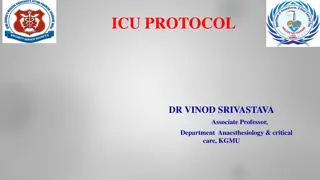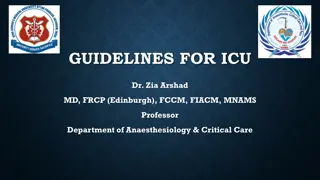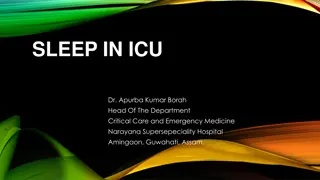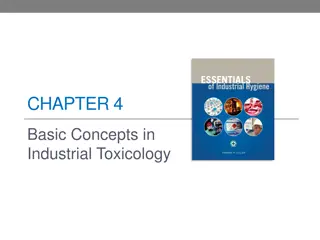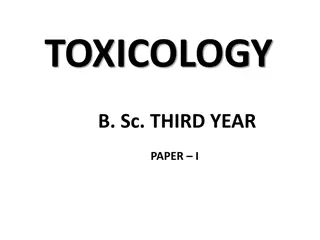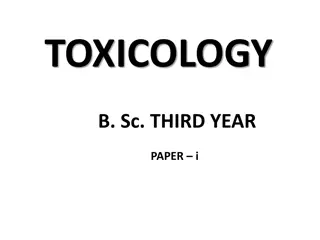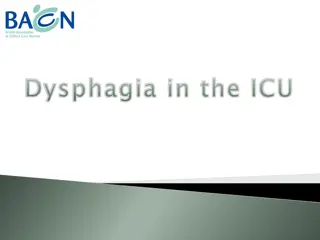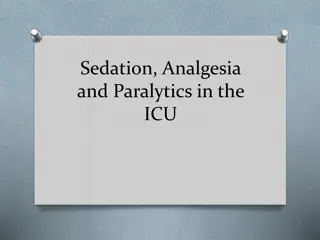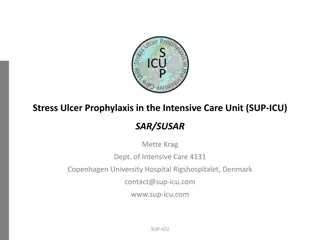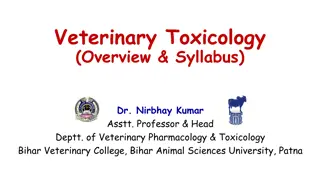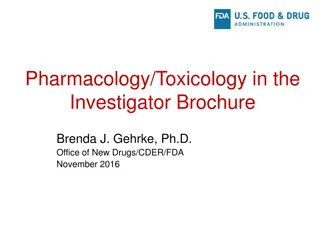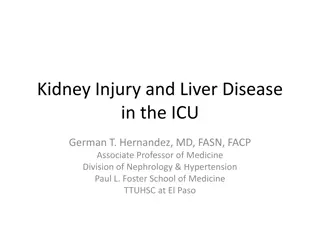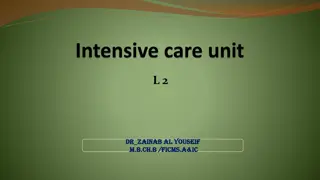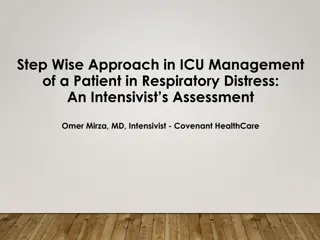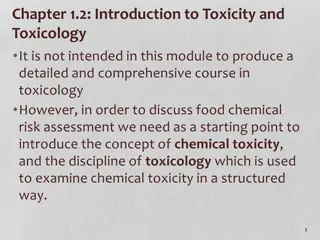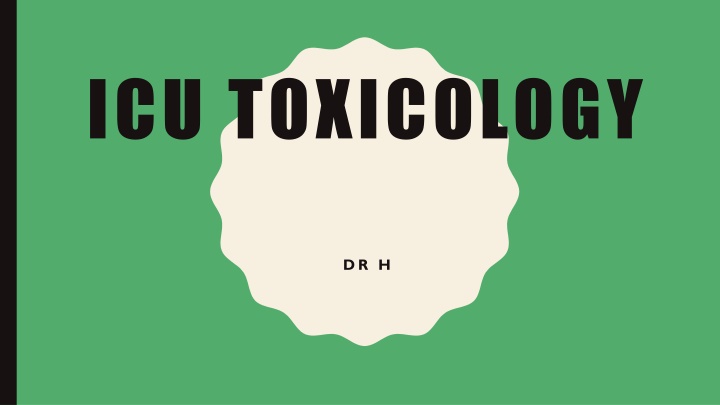
Toxicology in ICU: All You Need to Know
Dive into the world of toxicology in the intensive care unit with detailed information on toxic substances, treatment protocols, common overdose scenarios, and general considerations for managing poisoned patients. Explore key concepts such as toxidromes, street drugs, decontamination methods, and the importance of benzodiazepines in toxicology emergencies.
Download Presentation

Please find below an Image/Link to download the presentation.
The content on the website is provided AS IS for your information and personal use only. It may not be sold, licensed, or shared on other websites without obtaining consent from the author. If you encounter any issues during the download, it is possible that the publisher has removed the file from their server.
You are allowed to download the files provided on this website for personal or commercial use, subject to the condition that they are used lawfully. All files are the property of their respective owners.
The content on the website is provided AS IS for your information and personal use only. It may not be sold, licensed, or shared on other websites without obtaining consent from the author.
E N D
Presentation Transcript
ICU TOXICOLOGY DR H
ALL THINGS ARE POISONS, FOR THERE IS NOTHING WITHOUT POISONOUS QUALITIES. IT IS ONLY THE DOSE WHICH MAKES A THING POISON. PARACELSUS
T H E O B R O M I N E T O X I C I T Y 1 0 0 0 M G / K G I N H U M A N S 2 0 0 M G / K G I N C AT S 3 0 0 M G / K G I N D O G S
OBJECTIVES Street Drugs Toxidromes Treatment for Poisoning
TENANTS TO ALL EMERGENCY CARE 1-800-222-1222 Secure the airway Place the patient on a monitor! Have IV access (lots of it) Provide supportive care Serial EKGs and labs Benzodiazepines are your toxicology friend
GENERAL CONSIDERATIONS IN OVERDOSE AND ALTERED MENTAL STATUS Dextrose (1 amp) Thiamine (100mg) Naloxone (0.2-0.4mg escalate to 2 to 10mg if necessary) Ideally you don t want to precipitate withdrawal but personally I don t care if a patient has stomach cramps if I save their life Consider a gtt Monitor for seizures if OD is with tramadol or meperidine Little known fact, naloxone is good for Clonidine OD!
GI DECONTAMINATION I rarely do it. If you do it, contraindications include compromised airway, ileus, and bowel obstruction Activated Charcoal 0.5-1 g/kg in children or 25 to 100 g in adults Ingestion was <1 hour ago and the drug is known Salicylate Whole Bowel Irrigation large volumes (1.5-2 L/h) of a polyethylene glycol-based solution to facilitate rapid transit of a toxin through the GI tract. In volunteer consider following ingestion highly toxic, extended-release preparations verapamil, iron, asymptomatic drug packers
TO UDS OR TO NOT UDS Actual and Factual benzodiazepine testing is for oxazepam cannabinoid testing is for d -9- tetrahydrocannabinol False Negatives Drug Amphetamine Barbituate Benzodiazepine Cocaine Marijuana Opiates Phencyclidine Detection Period 4d 24h (sa) 3 wk (la) 3d (sa) 4 wk (la) 3d 3d (su) 4wk (lu) 4d 8d Lorazepam and Alprazolam have different metabolites Synthetic Opiates (fentanyl, Demerol, methadone, propoxyphene) Synthetic Cannabinoid (JWH-018 aka Spice) False Positives Amphetamines (pseudoephedrine) Benzodiazepines (some NSAIDs) Opiate (quinolones) PCP (diphenhydramine) TCA (diphenhydramine, cyclobenzaprine, carbamazepine, quetiapine)
LEVELABLE DRUGS Digoxin Salicylate Acetaminophen Theophylline Alcohols Ethylene Glycol, EtOH, Methanol Metals Iron, Lead, Mercury AEDs Valproate Carbamazepine Phenytoin Lithium Heme (arterial oxygen saturation gap PO2-Coox >5%) Carbon Monoxide, Carboxyhemoglobin, Methemoglobin, Sulfhemoglobin
DIALYZABLE DRUGS Salicylates Phenobarbital Theophylline Methanol Ethylene glycol Lithium Diethylene glycol Propylene glycol Isopropyl alcohol Valproic acid Carbamazepine
ANION GAP TOXICOLOGY IS ITS ONLY TRUE APPLICATION +AG unmeasured anions tells you to order an Osm Gap Toxic Alcohols -AG Lithium, Bromide, Iodide
OPIATES Smack, Horse, Mud, Brown Sugar, Junk, Black Tat, Big H, Paregoric, Dover s Powder, MPTP (New Heroin), Hilbilly Heroin, Lean or Purple Drank, OC, Ox, Oxy, Oxycotton, Sippin Syrup Tablets, capsules, skin patches, powder, chunks in varying colors (from white to shades of brown and black), liquid form for oral use and injection, syrups, suppositories, and lollipops swallowed, smoked, sniffed, or injected Poppy papaver somniferum is the source for all natural opioids Highly addictive Narcotic = Stupor dulls the senses and relieves pain
OPIATE TOXIDROME MORPHINE, HYDROCODONE, CODEINE, HYDROMORPHONE, FENTANYL, PROPOXYPHENE, TRAMADOL, METHADONE Lethargy Hypothermia Respiratory Depression Bradycardia and Hypotension Miosis Decreased Bowel Sounds Miosis and a respiratory rate of 12 breaths/min are both sensitive (88% and 80%, respectively) and specific (90% and 95%, respectively) for predicting a response to naloxone.
OPIATE TOXIDROME Altered mental status with depressed respiratory function Seizures: meperidine, propoxyphene, and tramadol QRS Prolongation: propoxyphene sodium channel blockade QT Prolongation: methadone potassium efflux blockade Chest Wall Rigidity: fentanyl (rapid infusion) Protect the airway Naloxone: 0.2-0.4mg escalate to 2 to 10mg if necessary Half-life ~2 hours Consider gtt Consider sodium bicarb and benzo s depending on presentation (seizures, abnl intervals on EKG, etc)
OPIATE WITHDRAWAL Restlessness Clonidine (anxiety) Mydriasis Ibuprofen (myalgias) Lacrimation Dicyclomine (abd cramps) Yawning Ondansetron (emesis) Insomnia Consider methadone N/V/D Muscle Cramps (including smooth muscle of intestine)
DEPRESSANTS Barbs, Benzos, Downers, Georgia Home Boy, GHB, Grievous Bodily Harm, Liquid X, Nerve Pills, Phennies, R2, Reds, Roofies, Rophies, Tranks, and Yellows Pills, syrups, and injectable liquids Euphoria Misused to facilitate sexual assault
SEDATIVE HYPNOTIC SYNDROME BARBITUATES, BENZODIAZEPINES, GHB, ETOH Lethargy Protect the airway via binding at postsynaptic g -aminobutyric acid type A channels , thereby promoting chloride influx and neuronal hyperpolarization Respiratory Depression Hypothermia CNS depression is enhanced
SEDATIVE HYPNOTIC SYNDROME Baclofen Protect the airway Hypothermia, hypotension, bradycardia, coma, seizures -Hydroxybutyrate Benzodiazepines for seizures CNS depression and respiratory failure Carisoprodol Coma and myocolonus
SEDATIVE HYPNOTIC WITHDRAWAL Tremors Benzodiazepines Hallucinations Can consider beer Agitation Supplement (decrease amt of benzo s) Dexmedetomidine Confusion Gabapentin Autonomic overactivity Seizures
METHAMPHETAMINE Batu, Bikers Coffee, Black Beauties, Chalk, Chicken Feed, Crank, Crystal, Glass, Go-Fast, Hiropon, Ice, Meth, Methlies Quick, Poor Man s Cocaine, Shabu, Shards, Speed, Stove Top, Tina, Trash, Tweak, Uppers, Ventana, Vidrio, Yaba, and Yellow Bam Pills, powder, rocks, and injectable liquids swallowed, smoked, sniffed, or injected Highly addictive Stimulant (CNS) Acute rush (thought to be from dopamine) Chronic Violence, anxiety, confusion, insomnia, psychosis
SYMPATHOMIMETIC TOXIDROME COCAINE, AMPHETAMINES, PCP, CAFFEINE, PSEUDOEPHEDRINE, METHYLPHENIDATE Mydriasis Diaphoresis Hyperthermia Agitation & muscular hyperactivity Tachycardia HTN Tachypnea Hypervigilence Psychosis Seizures Cocaine toxicity responds well to benzodiazepines Amphetamines are hit or miss
HALLUCINOGENS Acid, Blotter, Blotter Acid, Cubes, Doses, Fry, Mind Candy, Mushrooms, Shrooms, Special K, STP, X, and XTC Ecstasy is sold in colorful pill form LSD is sold in the form of impregnated paper (blotter acid), typically imprinted with colorful graphic designs. Synthetic THC is also called K2 or Spice Deaths exclusively from acute overdose of LSD, magic mushrooms, and mescaline are extremely rare. Deaths generally occur due to suicide, accidents, and dangerous behavior, or due to the person inadvertently eating poisonous plant material. Synthetic THC however has been associated with MI and Renal Failure Perceptual Distortions Time and Space Colors seem to change and take on new significance Weeks or even months after some hallucinogens have been taken, the user may experience flashbacks fragmentary recurrences of certain aspects of the drug experience in the absence of actually taking the drug.
HALLUCINOGENS MDMA can also act as a sympathomimetic IVF In high doses, it interferes with the body s ability to regulate temperature. Benzodiazepines Cooling device Hyperthermia can result in liver, kidney, and cardiovascular failure (i.e. death)
INHALANTS Gluey, Huff, Rush, and Whippets Chemical Vapors From: glue, lighter fluid, cleaning fluids, and paint Rapid absorption through the lungs to the brain Euphoria and feeling high Routine use will cause brain damage Death can occur from asphyxiation
DESIGNER CATHINONES AKA BATH SALTS Bliss, Blue Silk, Cloud Nine, Drone, Energy-1, Ivory Wave, Lunar Wave, Meow Meow, Ocean Burst, Pure Ivory, Purple Wave, Red Dove, Snow Leopard, Stardust, Vanilla Sky, White Dove, White Knight, White Lightening Usually sniffed or snorted. Can also be ingested, smoked, or injected Euphoria and Alertness (similar to cocaine and MDMA) Adverse Effects: Tachycardia, HTN, Hyperthermia, Mydriasis, Rhabomyolysis, Paranoia, Hallucinations/Delusions IVF Benzodiazepines
ANTICHOLINERGIC (ANTIMUSCARINIC) TOXIDROME ANTIHISTAMINES, TCAS, ANTIPYSCHOTICS, ANTIPARKINSONIAN, ANTISPASMODITCS/MUSCLE RELAXANTS, BELLADONNA ALKALOIDS/JIMSONWEED, OPHTHO MYDRIATICS, AMANITA MUSHROOMS Blind as a bat (mydriasis with loss of accommodation) Mad as a hatter (delirium) Red as a beet (flushed) Hot as hell (hyperthermia) Dry as a bone (anhydrosis) Loss of tone (constipation and urinary retention) Heart runs alone (tachycardia) PHYSOSTIGMINE 0.5-2mg IM/IV as needed Repeat q10-30 min HAVE ATROPINE AVAILABLE!
CHOLINERGIC TOXIDROME ORGANOPHOSPHATES, CARBAMATES, PHSYO/PYRIDOSTIGMINE, NERVE GAS, MUSCARINE MUSHROOMS Inhibit neuronal acetylcholinesterase (AChE), resulting in acetylcholine accumulation and overstimulation of muscarinic and nicotinic receptors Miosis Salivation Lacrimation Diaphoresis Bronchorrhea (with bronchospasm) Urination N/V/D Bradycardia ATROPINE 2-4mg IM x1 mild/moderate symptoms 6mg IM x1 severe symptoms Go half dose if elderly PRALIDOXIME (2-PAM) 1-2GM IV x1, then 250mg IV q5min until symptoms reverse Give 1 dose atropine first Of note, respiratory muscle paralysis does not respond to atropine Nicotinic hyperstimulation
SEROTONIN SYNDROME VS NEUROLEPTIC MALIGNANT SYNDROME NMS: Dopaminergic withdrawal, Haloperidol, SS: SSRIs, SNRIs, Bupropion, TCA, MAOIs, Anti-migraine, Lithium, Cyclobenzaprine, Fentanyl, Tramadol, Dextromethorphan, St. John s Wart, Ginseng, Nutmeg, Anti-nausea, Linezolid, Ritonavir Fluphena/Thiorida-zine, Chlorpromazine, Cloza/Olanza/Quetia -pine, Risperi/Ziprasi -done, Metoclopramide, Promethazine, Aripiprazole, Droperidol, Procholeperazine
SS VS NMS SS NMS (RESTORE DOPAMINE) MILD TO MODERATE MILD Bromocryptine 2.5-5mg q8h (max 30mg/day) Benzo s Amantadine 100mg q8h (200-400mg/day) MODERATE Cyproheptadine (5-HT2Aantagonist) SEVERE Intubate and Sedate (benzo gtt) Consider paralysis Antihypertensive gtt? Cooling device I also give cyproheptadine Consider benzo s MODERATE TO SEVERE Dantrolene 1-2.5mg/kg IV (1mg/kg q6h) Consider ECT if neuroleptic cannot be restarted
ACETAMINOPHEN The earlier the NAC, the better (treat until you can trend the acetaminophen level) 140mg/kg loading dose po followed by 70mg/kg q4h x 17 doses po (tastes gross!) 150mg/kg over 15-60 min followed by 12.5mg/kg/hr x 4 hours followed by 6.25mg/kg/hr x 16 hours Consider longer treatment if levels are still high (or LFTs are still abnl) Stages Preclinical Hepatic Injury Hepatic Failure Recovery 5% of the dose is metabolized by CYPP450 2E1 to N-acetyl-benzoquinone imine (NAPQI) NAPQI is toxic (covalent binding to proteins and nucleic acids) Glutathione detoxifies NAPQI (to cysteine and mercapturic acid conjugates) N-acetylcysteine is synthesized to cysteine to improve glutathione stores Transplant: Arterial pH < 7.3 despite resuscitation Or the combination of grade III/IV hepatic encephalopathy, prothrombin time >100 s, and serum creatinine level > 3.4 mg/dL.
SALICYLATES Mechanism uncoupling of oxidative phosphorylation, decreased adenosine triphosphate (ATP) production, increased acidosis, and hyperthermia Symptoms Mild: tinnitus, hyperventilation, abdominal pain, vomiting (if intubated keep that respiratory drive!) Severe: diaphoresis, delirium URINARY ALKALINIZATION 44-100mEq in 1L of 5% dextrose in 0.25% NS 88-150mEq in 1L of 5% dextrose at 2-3mL/kg/h (adults 150-200mL/h) Goal urine pH 7-8.5 / (keep blood pH <7.55) (monitor hourly) Hypokalemia & Hypovolemia prevent effective alkalinization Add 20-40mEq of K to each liter (unless there is renal failure) Urinary excretion is more dependent upon urine pH than renal flow rate trapping salicylates in urine and serum (increasing excretion and decreasing further redistribution, esp to the brain) HEMODIALYSIS AMS, Pulmonary edema, Seizures, Elevated and rising levels (100 mg/dL)
CARDIAC GLYCOSIDES DIGOXIN Inhibit the sodium-potassium ATPase pump intracellular sodium&calcium and extracellular potassium Increased contractility Increased automaticity with bradycardia and conduction blocks DIGOXIN-SPECIFIC FAB FRAGMENTS hyperkalemia (>5.5 mEq/L) and life-threatening dysrhythmias #vials = dig level (ng/mL) x wt (kg) / 100 (give 6 if unsure) #vials = 10 every 25 tabs/caps ingested acutely
INTRALIPID THERAPY In the event of local anesthetic-induced cardiac arrest that is unresponsive to standard therapy, in addition to standard cardio-pulmonary resuscitation, Intralipid 20% should be given i.v. in the following dose regime: Intralipid 20% 1.5mL/kg over 1 minute Take a 500ml bag of Intralipid20%and a 50ml syringe. Drawup 50ml and give stat i.v.X2 Then attach the Intralipid bag to an iv administration set (macrodrip) and run it i.v. over the next 15 minutes Repeat the initial bolus up to twice more if spontaneous circulation has not returned. Follow immediately with an infusion at a rate of 0.25mL/kg/min Continue chest compressions Repeat bolus every 3-5 minutes up to 3 mL/kg total dose until circulation is restored Continue infusion until hemodynamic stability is restored. Increase the rate to 0.5 mL/kg/min if BP declines A maximum total dose of 8mL/kg is recommended (560mL for a 70kg man) Developed for LAST Case reports in almost everything Olanzapine Lamotrigine Bupropion Dosulepin Verapamil Haloperidol Quetiapine Sertraline
CALCIUM CHANNEL BLOCKER & BETA BLOCKER OVERDOSE GLUCAGON HIGH-DOSE INSULIN THERAPY IVF Baseline glucose (goal ~200mg/dL) 1U/kg bolus 0.5-1.0 U/kg/h continuous infusion IVF 50 to 150 mcg/kg bolus (3-10mg for a 70kg person) Repeat q3-5 minutes Continuous infusion Initiate if more than two boluses given Dose by effective bolus dose each hour (for example, if two 5mg boluses given, rate should be 10mg/hr) Increase by 2U/kg/h every 10 min to a max of 10U/kg/h Dextrose infusion 10% in NS or 5-10%D5W, goal glucose >100 Monitor Glucose q10min & Potassium q60min while titrating insulin Glucose q30-60 min & Potassium q6h when infusion rate stable
TOXIC ALCOHOLS (ETHYLENE GLYCOL &METHANOL) Ethylene glycol Ophthalmoplegia Cranial nerve palsies Hyporeflexia Myoclonus ATN Abnl (low) Ca, Mg, K Prevent renal failure (EG), permanent neurological damage, seizures, severe acidosis (and of course death) FOMEPIZOLE Ethylene Glycol & Methanol dosing: 15mg/kg IV q12h until level <20mg/dL; then 10mg/kg IV q12h x 4; Consider HD Consider 1-2 amps of Bicarb if pH <7.3 Administer cofactors: thiamine, folate, pyridoxine Ethanol can be substituted for fomepizole if it is unavailable Methanol Headache Confusion Vertigo Visual impairment & photophobia afferent pupillary defect is an ominous sign Blindness Pancreatitis
CARBON MONOXIDE Rapidly absorbed odorless gas 210x the affinity for Hgb than O2 Shifts Oxygen-Dissociation curve to the left Headache, Dizziness, Nausea Confusion Coma Death MI can occur Diagnose with multiwavelength co-oximetry BUT TREAT BY SYMPTOMS 100% OXYGEN HBO is controversial
CYANIDE Inhibits cytochrome a 3 in mitochondrial cytochrome oxidase, No electron transport, No oxygen consumption, No ATP! Rapid onset of: coma, seizure, metabolic acidosis, tachycardia, and hypotension SODIUM NITRITE & SODIUM THIOSULFATE 300mg IVx1 of Nitrite followed by 12.5GM IVx1 of Thiosulfate Increases MetHgb to remove HCN from tissues Thiosulfate turns HCN to thiocyanate which is renally excreted HYDROXOCOBALAMIN 5GM IV May repeat (doses of up to 20GM have been used) Turns HCN to cyanocobalamin which is renally excreted
HAVE A GOOD WEEKEND REMEMBER NO MORE THAN 12 SHOTS OF 40 PROOF ALCOHOL

